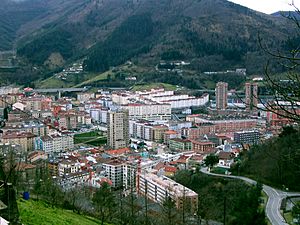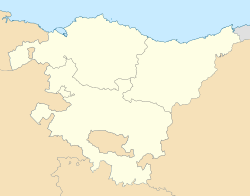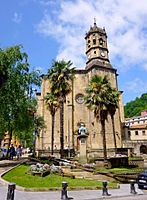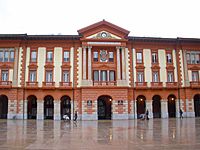Eibar facts for kids
Quick facts for kids
Eibar
|
|||
|---|---|---|---|
 |
|||
|
|||
| Country | |||
| Autonomous community | Basque Country | ||
| Province | Gipuzkoa | ||
| Eskualdea | Debabarrena | ||
| Area | |||
| • Total | 24.56 km2 (9.48 sq mi) | ||
| Elevation | 121 m (397 ft) | ||
| Population
(2018)
|
|||
| • Total | 27,406 | ||
| • Density | 1,115.88/km2 (2,890.1/sq mi) | ||
Eibar (Basque: Eibar, Spanish: Éibar) is a town and municipality in the province of Gipuzkoa. It is located in the Basque Country region of Spain. Eibar is also the main town of the Debabarrena area.
In 2018, Eibar had about 27,138 people living there. The town is famous for making things out of metal. Since the 1500s, Eibar has been known for making weapons, especially small, beautifully decorated guns. It was also where Serveta scooters were made.
Eibar is home to the SD Eibar soccer team.
Contents
Discovering Eibar's Location and Nature
Eibar is located 121 meters (about 397 feet) above sea level. It is in the western part of the Gipuzkoa province, very close to another area called Biscay. Eibar has an oceanic climate, which means it gets a lot of rain and has mild temperatures.
The town sits in a narrow valley surrounded by mountains. Some of these mountains, like Karakate, Kalamua, and Akondia, are quite tall, reaching between 700 and 800 meters (about 2,300 to 2,600 feet). The Ego River flows through Eibar. This river eventually joins the Deba River.
Besides the main town area, Eibar also includes five smaller rural neighborhoods. These are Otaola-Kinarraga, Aginaga, Arrate, Mandiola, and Gorosta.
Eibar's Journey Through Time
Eibar became an official town in 1346. It was given its name, Villanueva de San Andrés de Heybar, by King Alfonso XI of Castile.
In the past, powerful families in the area often fought each other in something called the War of the Bands. Eibar, like other towns in the valley, had an industry focused on shaping metal and making weapons. In 1766, the town experienced a big protest known as the Machinada. Later, in 1794, French forces attacked Eibar and destroyed much of the town.
In the 1800s, new factories changed how things were made in Eibar. This led to big changes in how people worked and lived. During the French Revolutionary Wars in 1793, Eibar temporarily decided to join Biscay. Later, in the Carlist Wars, Eibar supported the Liberals, a political group. The idea of workers' rights and social change became very strong in Eibar. In 1931, Eibar was the first city in Spain to declare the Second Spanish Republic. Because of this, it was given the special title of "Very Exemplary City".
During the Spanish Civil War, Eibar was almost completely destroyed by Italian bombers who were helping the Nationalists. After the war, the town was rebuilt. This led to a lot of new factories and a big increase in people moving to Eibar. The population grew to almost 40,000 in just a few years.
Because there wasn't enough space to build more factories, some businesses moved to other areas like Durangaldea and Álava. In the 1980s, many factories faced problems, and Eibar lost a lot of its population.
Today, in the 21st century, Eibar's economy is based on both industry and services.
Places to See in Eibar
Eibar has several interesting historical buildings and places to visit:
- Church of San Andrés: This church was built between the 1500s and 1600s. It has a Gothic style with parts that look like Renaissance and Baroque art.
- Sanctuary of the Virgin of Arrate: This special church dates back to the early 1600s.
- Hermitage of Azitain: This small chapel has a unique statue of Christ from the 1600s.
- Palace of Unzueta: A grand building from the 1600s.
- Palace of Aldatze: Another palace built in the 1600s.
- Palace of Markeskua: This palace is even older, from the 1500s.
- City Hall: The town's government building was designed by architect Ramón Cortázar. It was opened on September 14, 1901, and is built over the Ego River.
- Coliseo Theatre: This theater first opened in 1947 and was updated in 2007.
Getting Around Eibar
Roads and Buses
Eibar is connected by major roads. The AP-8 motorway runs through Eibar, linking it to Bilbao and the border with France. The N-634 road runs next to it. Another motorway, the AP-1, connects Eibar to Vitoria-Gasteiz. These two motorways meet at a big junction called Maltzaga in eastern Eibar.
There are many regular bus services that connect Eibar to nearby towns, San Sebastián, Vitoria-Gasteiz, and Bilbao Airport. BizkaiBus also offers frequent bus services to and from Bilbao. If you want to travel further, ALSA has a daily bus service to Madrid-Barajas Airport and Madrid.
Eibar also has its own local bus service called Udalbus, which helps people get around town.
Train Travel
Eibar is on a narrow gauge railway line that goes from Bilbao to San Sebastián. Trains run often, connecting Eibar to Bilbao-Matiko station and Donostia-Amara station. Trains are even more frequent in the section between Ermua, Eibar, and Elgoibar.
There are five train stations in Eibar: Unibertsitatea-Eibar, Amaña-Eibar, Ardantza-Eibar, Eibar, and Azitain-Eibar.
Learning in Eibar
Eibar is home to a campus of the Gipuzkoa Faculty of Engineering, which is part of the University of the Basque Country. Here, students can study renewable energy engineering.
The Escuela de Armería, founded in 1913, is the oldest vocational training school in Spain. It teaches practical skills for different jobs.
Sports in Eibar
Football
Eibar is well-known for its football team, SD Eibar. The men's team was promoted to La Liga, Spain's top football league, in the 2013-14 season. They played there for seven seasons before moving back to the Segunda División in the 2020–21 season. The team plays their home games at the Ipurua Municipal Stadium.
The women's team of SD Eibar also moved up to the Primera División, the top women's league, in the 2019–20 season. After two seasons, they were relegated to Primera Federación in the 2021–22 season. They play at the Unbe Sports Complex.
Basque Pelota
The Astelena fronton in Eibar is a famous place for Basque Hand-pelota. It's even called the Cathedral of Basque Hand-pelota! Many professional competitions, like the Bare-handed Pelota First League and the Cuatro y Medio Euskadi Championship, are held here.
Cycling
Since 2009, Eibar has been a regular finish point for a stage in the Tour of the Basque Country cycling race. Riders usually finish after climbing the challenging Alto de Arrate mountain. Before 2009, this was a traditional finish for another race called the Euskal Bizikleta, which actually started in Eibar. The Arrate finish has also been part of the Vuelta a España race in 1972, 1974, 2012, and 2020.
Famous People from Eibar
- Francisco de Ibarra (1539–1575), an explorer
- Martín Ignacio de Loyola (1550–1606), a missionary and navigator
- Ignacio de Soroeta (?–17??), a Governor of Paraguay
- Juan Antonio Mogel (1745–1804), a writer
- Plácido Zuloaga (1834–1910), a sculptor
- Ignacio Zuloaga (1870–1945), a painter
- Ciriaco Errasti (1904–1984), a footballer
- Baltasar Albéniz (1905–1978), a football manager
- Roberto Etxebarria Arruti (1908–1981), a footballer
- Víctor Lecumberri (1913–2005), a politician
- Miguel Gallastegui (1918–2019), a Basque pelotari (pelota player)
- Laura Irasuegi Otal (1923–2016), a civil engineer
- Alicia Iturrioz (1927–2021), a painter
- Alberto Ormaetxea (1939–2005), a footballer and football manager
- Luis Aranberri (1945–), a politician and journalist
- Javier Aguirresarobe (1948–), a cinematographer
- Koldo Zuazo (1956–), a linguist
- Enrique Zuazua (1961–), a mathematician
- Maite Zúñiga (1964–), an athlete
- Pedro Horrillo (1974–), a cyclist
- Patxi Usobiaga (1980–), a climber
- Markel Susaeta (1987–), a footballer
- Jon Errasti (1988–), a footballer
- Markel Alberdi (1991–), a swimmer
- Mikel Oyarzabal (1997–), a footballer
- Odei Jainaga (1997–), an athlete
See also
 In Spanish: Éibar para niños
In Spanish: Éibar para niños









